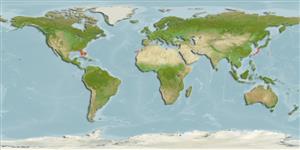Common names from other countries
Classification / Names / Names
Namen | Synonyme | Catalog of Fishes (gen., sp.) | ITIS | CoL | WoRMS
Environment: milieu / climate zone / depth range / distribution range
Ökologie
; tiefenbereich 0 - 20 m (Ref. 7727). Tropical; 32°N - 24°N, 97°E - 25°E (Ref. 83435)
Circumglobal in tropical and temperate warm seas and introduced in the Mediterranean.
Length at first maturity / Size / Gewicht / Alter
Maturity: Lm ? range ? - ? cm Max length : 41.0 cm TL Männchen/unbestimmt; (Ref. 126605); max. veröff. Gewicht: 1.4 kg (Ref. 126605); max. veröff. Alter: 1.00 Jahre (Ref. 126605)
Sea hares have annual life cycles (Ref. 126605). Common on tidal platforms of mixed sand and rock; actively crawling in tide pools at night and in crevices and under rocks during the day (Ref. 866). Grazes on various types of green algae (Ref. 844). Found in warm seas (Ref. 822). Known from depths of 0 to 20 m (Ref. 7727); from low intertidal to immediate subtidal on alga-covered reefs (Ref. 337). Ejecting ink as a predator deterrence and to send alarm signals to conspecifics, but not all spotted sea hares have ink (Ref. 84419). Ink components are based on the chemical properties of their diet (Ref. 84420). Ascorhynchus sp. found parasitic on the gills of this nudibranch (Ref. 121217).
Life cycle and mating behavior
Geschlechtsreife | Fortpflanzung | Ablaichen | Eier | Fecundity | Larven
Members of the order Anaspidea are mostly simultaneous hermaphrodites.
Debelius, H. 2001. (Ref. 844)
IUCN Rote Liste Status (Ref. 130435)
CITES Status (Ref. 108899)
Not Evaluated
Not Evaluated
Nutzung durch Menschen
| FishSource |
Tools
Internet Quellen
Estimates based on models
Preferred temperature
(Ref.
115969): 20.2 - 26.8, mean 24.6 (based on 196 cells).
Verwundbarkeit
Low to moderate vulnerability (30 of 100).
Preiskategorie
Unknown.
